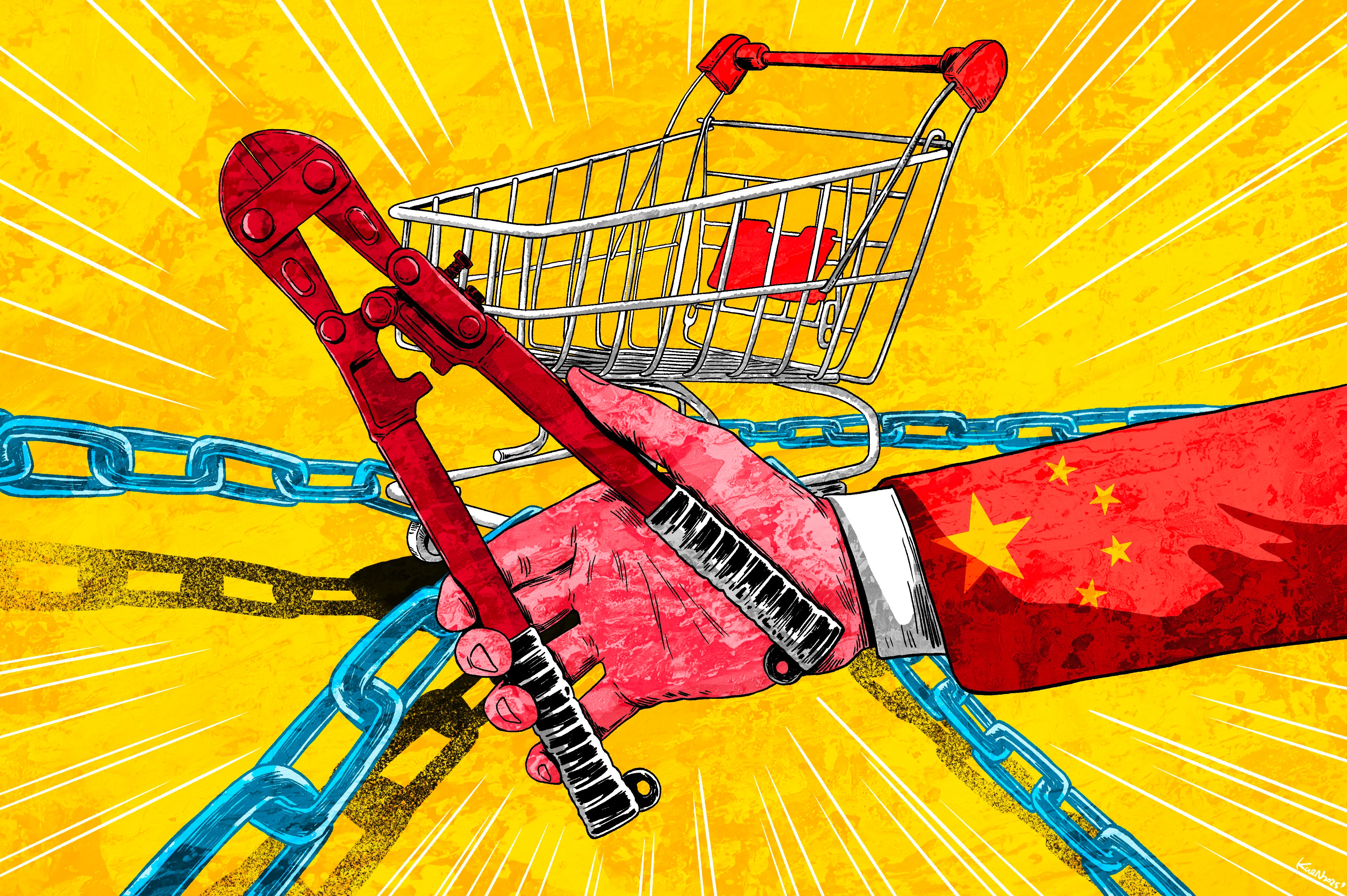By Luna Sun
Copyright scmp

As China drafts its 15th five-year plan ŌĆō the next entry in a line of expansive blueprints that have set the tone for the countryŌĆÖs development over more than seven decades ŌĆō we examine how these documents inform and reflect high-level policy priorities, what to expect in the coming iteration and whether it will expand on existing initiatives to boost domestic consumption.
For more stories in this ongoing series, click here.
Five years ago, Joe Zhang was a high-flying analyst at a Beijing-based foreign company. And he was content splashing out his bonuses on a US$3,000 Balenciaga jacket, while eyeing a designer watch priced like a car.
How times have changed. After being laid off, he took a job at a state-owned logistics firm, and his salary was halved. Luxury apparel and flashy timepieces are no longer on ZhangŌĆÖs radar ŌĆō he is looking to save money. The 36-year-old now settles for US$30 knock-off items, and vacation getaways are out of the question.
The sharp swing in ZhangŌĆÖs consumption habits is one shared by countless Chinese people at a time of employment uncertainty, stagnant wage growth, investment downturns and deflationary risks. And for many, how the economy fares in the coming years will determine how much more they dare to spend.
ŌĆ£IŌĆÖm basically eating in my old savings now,ŌĆØ Zhang said. ŌĆ£I have almost no new savings coming in every month, and I have to work really hard just to put a little aside.ŌĆØ
Thus, considerable hope is being placed on ChinaŌĆÖs upcoming five-year economic road map (2026-2030), which will be deliberated by policymakers in October and could serve as a blueprint to revive gross domestic product growth, shore up the job market, boost household income and restore peopleŌĆÖs confidence to invest and spend.
China has been grappling with weak demand since consumer confidence was shaken by the pandemic that started in 2020. Stimulus measures involving cars and durable goods have boosted spending but have done little to revive sentiment.
Zhuang Bo, a global macro strategist at Loomis Sayles Investment Asia, noted that since ŌĆ£household consumption is mainly driven by expectations, a government plan alone wonŌĆÖt change how people feelŌĆØ.
ŌĆ£The real test for the 15th five-year plan is to shift from directing investment flows to effectively shaping consumer expectations in order to boost actual spending,ŌĆØ Zhuang said. ŌĆ£I think that will be a very big challenge.ŌĆØ
Past five-year plans have largely focused on managing production and boosting public spending, effectively steering investment flows through government policy, Zhuang explained. But when it comes to stimulating private consumption ŌĆō long given little weight in ChinaŌĆÖs planning ŌĆō he added, the policy influence is far less direct.
In the nationŌĆÖs 13th five-year plan (2016-2020), boosting the role of consumption in growth was deemed a national goal. The plan pledged to ŌĆ£promote consumption upgrades, create consumer demand, and continuously strengthen the fundamental role of consumption in driving the economyŌĆØ.
It also called for tapping rural consumption potential, expanding household spending, prioritising services to drive structural upgrading, and supporting new forms of consumption such as information, green, fashion and quality goods ŌĆō alongside the steady promotion of big-ticket items, including housing, cars, healthcare and elderly care.
The 14th five-year plan (2021-2025) put greater emphasis on manufacturing and tech self-reliance, as the country was fighting WashingtonŌĆÖs supply-chain-decoupling endeavours and tech curbs.
But the plan still vowed to ŌĆ£deeply implement the strategy of expanding domestic demand; enhance the fundamental role of consumption in economic development and the key role of investment in optimising the supply structure; and build a strong domestic market with robust consumption and investment demandŌĆØ.
Boosting domestic consumption has become a priority for China as it seeks to rebalance the economy and offset the impact of heightened trade tensions with the United States. Yet, convincing families to spend has been an uphill battle.
Dinny McMahon, head of China markets at policy research firm Trivium, said Beijing cracked down on the overheated property sector in 2020 and wanted to replace it with a new, productivity-led growth model.
ŌĆ£Services could be back in the next five-year plan, because officials have been speaking about how Chinese householdsŌĆÖ consumption of goods is already at international levels, which means that any hopes of accelerating the growth of household consumption will have to come from services,ŌĆØ McMahon said.
The worldŌĆÖs second-largest economy has been promoting the idea of boosting consumption by unlocking latent demand, and the focus has pivoted from physical goods in recent years to services this year.
However, McMahon also said that encouraging the development of services ŌĆ£isnŌĆÖt a solution to weak consumption, but merely recognition that consumption patterns will increasingly favour services, and that creates new business opportunitiesŌĆØ.
The president of Shanghai University of Finance and Economics, Liu Yuanchun, said in a recent Securities Times interview that boosting consumption should not rely on short-term stimulus, but instead be driven by income-distribution reform, innovation in consumption scenarios, and the removal of supply bottlenecks.
Expanding social security coverage, he added, ŌĆ£requires the government to adjust its fiscal-spending structure, shifting appropriately from an investment-driven model to one more oriented towards public services and peopleŌĆÖs livelihoodsŌĆØ.
ChinaŌĆÖs reliance on consumption to drive growth remains well below that of many advanced economies. Consumption accounted for 56.6 per cent of ChinaŌĆÖs GDP in 2024, roughly unchanged from recent years and 17 percentage points below the world average, according to World Bank data.
The gap is stark: consumption accounts for 81 per cent of output in the US, 75 per cent in Japan and 68 per cent in South Korea. Even emerging economies such as India, 71 per cent; Thailand, 74 per cent; Vietnam, 63 per cent; and Brazil, 82 per cent, surpass China in this respect.
In terms of growth, consumption was responsible for 44.5 per cent of ChinaŌĆÖs GDP expansion last year, increasing 2.2 percentage points from 2023 ŌĆō underscoring how consumptionŌĆÖs role remains limited compared with investment and manufacturing.
Liu, who also offers advice to Chinese leaders on economic policies, stressed that China should ŌĆ£explore an optimal consumption level with Chinese characteristics, rather than blindly benchmarking against [higher] consumption rates of the WestŌĆØ.
Beijing has made creating a ŌĆ£unified national marketŌĆØ central to its goal of ŌĆ£building a high-standard market economyŌĆØ by 2035. Greater interregional integration is seen as crucial to maximising the potential of the countryŌĆÖs production capacity, boosting domestic demand and eventually ŌĆ£smoothing out domestic circulationŌĆØ ŌĆō meaning the economic process of production, distribution and consumption within its own market. This is also one of the two pillars of ChinaŌĆÖs ŌĆ£dual-circulation strategyŌĆØ.
Meanwhile, China has started providing subsidies for childcare amid a decline in births in an increasingly ageing society. Yet, while analysts have hailed such moves as steps in the right direction ŌĆō addressing peopleŌĆÖs concerns while providing some support for consumption ŌĆō criticism has also been expressed about these measures not being sufficient to materially raise childbirth rates.
McMahon said confidence would be restored and consumption would accelerate if China could address problems related to declining home prices, lower wages, job insecurity and deflation arising from industrial overcapacity, as well as an inability among overly indebted local governments to pay arrears and the withholding of wages from state employees.
Failing that, he said, Beijing could be forced to begin redistributing wealth, but it has been ŌĆ£reluctant to do that on a large scale because it believes funding welfare with government debt is the road to economic ruinŌĆØ.
China should increase investment in areas that could spur economic activity, create jobs, boost confidence, and thereby create demand that does not currently exist, he added.
With household responses uncertain, more generous benefits could create short-term growth drags, though consumption should rise
Morgan Stanley note
According to a Bank of China research note published in May, growth in service consumption is a key focus for expanding domestic demand.
While services accounted for 45.2 per cent of household spending in 2023, the note said the share lagged far behind major developed economies: 67.5 per cent in the US, 56.2 per cent in Japan, 50.5 per cent in Germany, 56.6 per cent in France, and 59.8 per cent in South Korea.
And on a per capita basis, Chinese households spent around US$2,317 on services in 2023 ŌĆō just 6 per cent of US levels, and roughly 20 per cent of other leading economies.
The bank noted that survival-oriented services make up a relatively large share of ChinaŌĆÖs household consumption, while developmental and leisure services remain underdeveloped.
And as McMahon pointed out: ŌĆ£Skiing, holidays, cruises, pet care, music festivals ŌĆō these are things that people would like to have, but theyŌĆÖre not going to spend on this sort of stuff as long as consumer confidence is low.ŌĆØ
A note from Morgan Stanley also flagged the potential benefits of Chinese policymakers having the ŌĆ£courage to actŌĆØ, by spending more to achieve potentially greater results.
ŌĆ£With household responses uncertain, more generous benefits could create short-term growth drags, though consumption should rise,ŌĆØ it said in the September 14 note.
ŌĆ£Amplified by population ageing, it may compress investment space in the longer run. Yet, the upside is substantial: beyond the familiar goal of a more balanced growth mix with stable inflation, groundbreaking reforms could strengthen buffers for economic and technological transition and enhance labour force quality.
ŌĆ£These shifts would support productivity gains beyond ŌĆśhard technologyŌĆÖ and help counter demographic headwinds.ŌĆØ



